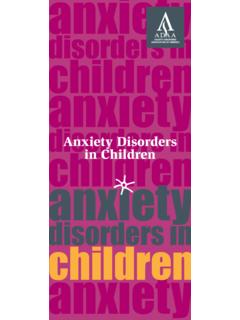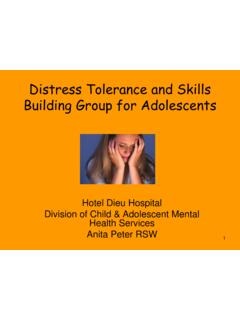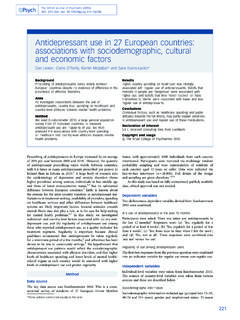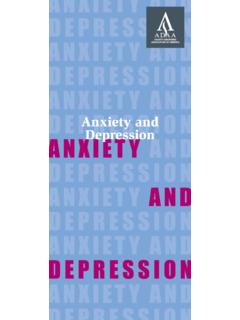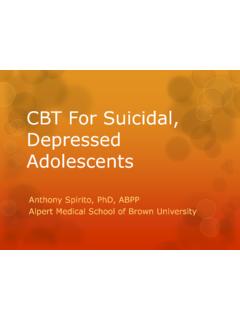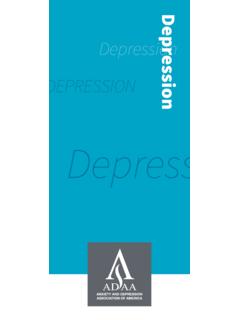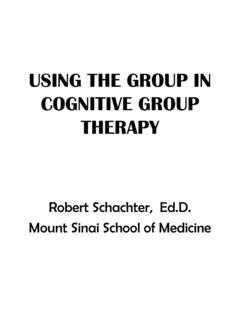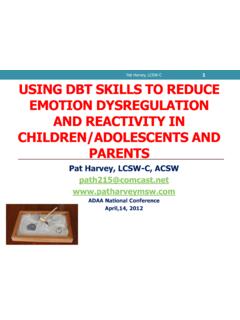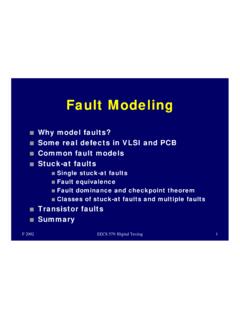Transcription of Stuck?! Enhancing Treatments for Anxiety and Depression ...
1 stuck ?! Enhancing Treatments FOR Anxiety AND Depression USING PRINCIPLES FROM DIALECTICAL BEHAVIOR THERAPY J E N N I F E R T A I T Z , P S Y. D. , A . B . P. P. A M E R I C A N I N S T I T U T E F O R C O G N I T I V E T H E R A P Y, N E W Y O R K , N Y W W W. D R J E N N Y T A I T Z . C O M Here s what I ve tried: individual psychotherapy (three decades of it), family therapy, group therapy, cognitive-behavioral therapy, rational emotive behavior therapy, acceptance and commitment therapy, hypnosis, meditation, role-playing, interoceptive exposure therapy, in vivo exposure therapy, self-help workbooks, massage therapy, prayer, acupuncture, yoga, Stoic philosophy, and audiotapes I ordered off a late-night TV infomercial.
2 And medication. Lots of medication. Thorazine. Imipramine. Desipramine. Chlorpheniramine. Nardil. BuSpar. Prozac. Zoloft. Paxil. Wellbutrin. Effexor. Celexa. Lexapro. Cymbalta. Luvox. Trazodone. Levoxyl. Inderal. Tranxene. Serax. Centrax. St. John s wort. Zolpidem. Valium. Librium. Ativan. Xanax. Klonopin. Also: beer, wine, gin, bourbon, vodka, and scotch. Here s what s worked: nothing. -- Scott Stossel, Surviving Anxiety , The Atlantic January/February 2014 PREVALENCE AND COMORBIDITY 40 million adults in the suffer from an Anxiety disorder (NIMH) More than half of people with one Anxiety disorder have another Anxiety disorder (Brown et al.)
3 , 2001) Among individuals who attempt suicide, 70% have an Anxiety disorder (Nepon, Belik, Bolton, & Sareen, 2010) Major Depressive Disorder affects approximately million adults Nearly half of the people who have a major depressive episode will also have an Anxiety disorder ( Reiger et 1998) In BPD populations, lifetime prevalence of Depression occurs in as many as 83% and Anxiety disorders occur in as many as 88% CURRENT CONCEPTUALIZATIONS Depression and Anxiety share common factors ( Fairholme, 2010) Research in affective science suggests moving toward examining broader shared constructs ( Brown & Barlow, 2009) Common process =emotion dysregulation Empirically supported Treatments target emotion regulation The mechanism of change in DBT is reducing ineffective actions associated with dysregulated emotions.
4 WHAT MIGHT BE GETTING US stuck ? Problematic expectations-on both sides! Poor therapeutic alliance Premature dropout Patient hopelessness/low motivation Lack of generalization to real world Therapist burnout Too many problems to juggle GOALS FOR TODAY familiarity with Dialectical Behavior Therapy (DBT) potential stuck points using DBT principles at least 5 DBT strategies to employ with your clients OVERVIEW OF DIALECTICAL BEHAVIOR THERAPY Comprehensive DBT includes: 1. skills training 2. individual therapy 3. coaching calls 4. team meetings These components aim to: 1. enhance clients capabilities 2.
5 Structure the environment to support the client 3. generalize client gains 4. heighten therapist motivation and competence *DBT is principle-based, not protocol- based* EFFICACY OF DBT COMPONENTS BEYOND BPD Bulimia nervosa and binge eating disorder ( Hill, Craighead, & Safer, 2011) ADHD (Hesslinger, 2002) treatment resistant Depression (Lynch et al., 2000, 2003; Harley, Sprich, Safren, & Jacobo, 2008) Depression in the elderly (DBT+MED) (Lynch, Morse, Mendelson, & Robins, 2003) Post-traumatic stress disorder (Bohus et al., 2013) DBT-enhanced habit reversal for trichotillomania (Keuthen et al., 2011) DBT FOR Depression 34 depressed adults over the age of 60 (M age = , ) recruited from the Clinical Research Center for the Study of Depression in Late Life at Duke Participants were randomly assigned to either an antidepressant condition (MED) or medication+ 14 weeks of DBT skills training + 30 minutes/week DBT phone coaching At post- treatment , 71% of MED+ DBT patients were in remission at post- treatment compared to 47% of MED alone patients.
6 At a 6-month follow-up, 75% of MED+DBT patients were in remission compared to only 31% of MED patients. (Lynch, Cheavens, Cukrowicz, Thorp, Bronner, & Beyer, 2007) treatment INNOVATIONS WE LL COVER TODAY Commitment strategies Validation Concrete skill instructions in distress tolerance and emotion regulation Extensive self-monitoring of emotions and skills DIFFERENTIATING B E H AV I O R T H E R A P I E S Exposure and response prevention Skills training Reinforcement Cognitive restructuring/distancing DBT Commitment strategies Validation as a skill set Mindfulness as a set of skills- wise mind, participate Dialectical focus Emotion regulation and opposite action skills Distress tolerance skills High therapist self-disclosure Telephone consultation DBT ASSUMPTIONS A B O U T T H E R A P Y The most caring thing a therapist can do is to help bring patients closer to their ultimate goals Clarity, precision, and compassion matter Principles of behavior affect both therapists and clients-they are universal The therapeutic relationship is a real relationship between equals A B O U T PAT I E N T S Patients are doing the best they can (and cannot fail in therapy)
7 Patients want to improve Patients need to do better, try harder, be more motivated Patients may not have caused their problems, but need to solve them Patients must learn new behaviors in all relevant contexts BIOSOCIAL THEORY Linehan, 1993 THE BIOSOCIAL MODEL FOR DISORDERS OF OVER CONTROL Lynch, Hempel, Dunkley, 2014 Allison At intake (November, 2013, BDI 35, BAI 56) four months later- BDI 9, BAI 17) 28-year-old female, longstanding history of generalized Anxiety , social Anxiety , and perfectionism. Developed panic disorder and was concurrently notably depressed and on medical leave from work. Mark 27-year-old male, long standing history of GAD, BDD, social Anxiety , MDD, OCPD, and physical pain.
8 Presented on medical leave, referred to me from prescribing psychiatrist to target SI. CASE EXAMPLES BEHAVIOR THERAPY Change your thinking and your behavior Intense arousal, sense of invalidation What happens to the therapeutic relationship? Problem Solving Validation Dialectics DIALECTICAL PHILOSOPHY According to Hegel, truth as a process that develops when opposing, valid positions integrate into a finer Assumption there is no single truth. Effective use of dialectical strategies allow a provider to circumvent a rigid argument, allowing a client to move towards goals. DIALECTICS IN DBT Dialectics is both a theory and a stylistic approach aimed to target dichotomous tendencies.
9 Example of dialectical assumption in DBT: Clients are doing the best they can and they need to do The need to simultaneously accept and change Dialectical philosophy also addresses a system as a whole DBT aims to treat whole patient rather than just the disorder. Also whole emotion system is targeted- all elements seen as interrelated. Linehan, 1993 ORIENTATION Ultimate treatment aim: A life worth living Informed consent to treatment / shared agreement on investment treatment hierarchy: Life threatening Therapy interfering Quality of life-interfering COMMITMENT STRATEGIES the pros and cons of making a change 2.
10 Foot in the door/Door in the face present commitments to previous commitments freedom to choose and the absence of alternatives s advocate 8. Agreement on homework Linehan, 1993, p. 286-291 VALIDATION, DEFINED The therapist communicates to the patient that her responses make sense and are understandable with her current life context or situation. The therapist actively accepts the patient and communicates this acceptance to the patient. The therapist takes the patient s responses seriously and does not discount or trivialize them --Linehan, 1993, Cognitive Behavioral treatment of Borderline Personality Disorder, p.
